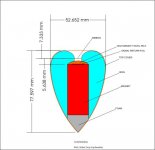Markus, thanks for the link. I have an older version of Sound Easy but i did not try the DSP software.
Buggsson, yes this spheres are from the fishing industry. By coincidence the factory is 3km from my house. The company is called Göbel Kunststoffe in Brilon. They make a lot of other stuff like flower potts etc. I have seen very interesting foamed plastic there too that is very rigid and very light.
The spheres are eather from PP or PE. They are extremely rigid and need no stiffening i think.
Buggsson, yes this spheres are from the fishing industry. By coincidence the factory is 3km from my house. The company is called Göbel Kunststoffe in Brilon. They make a lot of other stuff like flower potts etc. I have seen very interesting foamed plastic there too that is very rigid and very light.
The spheres are eather from PP or PE. They are extremely rigid and need no stiffening i think.
You would be surprised what the frequency content differences are. It's not just SPLs.😀After tweaking all that stuff, it may sound somewhat convincing, but not real.Who wants to listen to a firing tank at real SPLs, killing some hair cells and probably ruining his hearing forever?
Anyway, that doesn't change anything I've said in my last post. If your goal is realism in recodrings that really translate to other rooms then look at the tools and specs the movie industry has and compare that to what the music industry has to offer.
Joachim, You might be a bit late to get it for $25, but it might be worth a try.
Last edited:
You would be surprised what the frequency content differences are.
What are you comparing? What "stuff"?
Again, my initial comment wasn't about explosions but about the reality of music and movie sound reproduction. Music reproduction is a (highly compressed) mess.
What are you comparing? What "stuff"?
Again, my initial comment wasn't about explosions but about the reality of music and movie sound reproduction. Music reproduction is a (highly compressed) mess.
I think that this is well known and accepted, but is a fact we all have to - increasingly - live with.
What - to me - is so good about this thread is that the main contributors are obviously so aware of this fact that it is taken as a 'given'. Joachim, and probably others, also have a very good knowledge of small signal amplification design but are staying within the bounds of speaker design per se in this thread (as I read it with a pre-acceptance of all of the problems which come from down the chain including the recorded music itself.) They are attempting to come up with something which minimises the effects of earlier problems created between performance and signal entry to the speaker(s). The only alternative would be to design a total replay system.
If the rest of it were perfect all we would have to talk about is the relative merits or weaknesses of the original performance.
Another "good thing" about this thread is that the sceptics who are aggressively against every thing which they don't accept have mercifully kept out of it, thus allowing progress to be made.
I have now ordered the woofers so i think in the next two weeks a prototype will be made. Yes, we are making good progress here and i enjoy most of the contributions.
I also hope that i could make more clear what i am trying to do.
I also hope that i could make more clear what i am trying to do.
What's played from movies compared with reality. Come on, just with two speakers, the interaural effect decreases sense of realness. The more speakers you add, the more problems you end up with in terms of recreating the recorded sound. Whether or not music reproduction is messed in the production process is a different issue. I have recordings direct with no limiting or editing, I also have recorded some performances in the past just with a cassette deck played back using the same deck. So I do compare many things. Properly processed earphones will probably provide much more realistic sound than any speaker system. the only reason we don't use that kind of recording is that it costs too much to get the original recording right.What are you comparing? What "stuff"?
Again, my initial comment wasn't about explosions but about the reality of music and movie sound reproduction. Music reproduction is a (highly compressed) mess.
What's played from movies compared with reality. Come on, just with two speakers, the interaural effect decreases sense of realness. The more speakers you add, the more problems you end up with in terms of recreating the recorded sound. Whether or not music reproduction is messed in the production process is a different issue. I have recordings direct with no limiting or editing, I also have recorded some performances in the past just with a cassette deck played back using the same deck. So I do compare many things. Properly processed earphones will probably provide much more realistic sound than any speaker system. the only reason we don't use that kind of recording is that it costs too much to get the original recording right.
Well, guess we'll just have to agree to disagree.
P.S. Was your interest in literature regarding equal-loudness contours really honest? Haven't received your email address yet.
I have now ordered the woofers so i think in the next two weeks a prototype will be made. Yes, we are making good progress here and i enjoy most of the contributions.
I also hope that i could make more clear what i am trying to do.
Hello,
Good news regarding the woofers.
Fishing net floats, they must be the new version of the glass ones I have seen washed up on the beach.
DT
All just for fun!
Hello, Joachim!
Long time no see! Happy New 2011 to you and everyone!
I stumbled upon your thread here that relates diffraction.
If I may, I'll share my 2cents on this as I've played with designing a ribbon tweeter in a way to prevent the diffraction and improve the smoothness of the response.
What I'll say now, is valid only if you want to get the very best results in war against diffraction. For limited budget speakers, this may not be feasible.
When you think about diffraction, think in pressure gradients.
You shouldn't mount the diaphragm tangentially to the ball. In the vicinity of the diaphragm, pressure and velocity vectors are not aligned. Air molecules velocity will propagate in forward-back direction, but air pressure will try to move away in all directions as fast as possible, i.e. as soon as the path opens.
I wasn't able to analyze this directly, but there is a great deal of analogy that I see to propagation of magnetic fields, so i made predictions that turned out to be very good and the result was excellent in the first trial.
Anyway, housing must initially follow the particle velocity direction, allow for gradual alignment of velocity and pressure propagation along the way and slowly turn back. It looks pretty much like a short horn folding all the way back, with absorption at the meeting point in the back, which is optional.
Pictures and measurements attached. I don't consider the drawing confidential any more. I don't have the polar plot, but I bet it is at least 180 at 15k, as it sounded like that.
Frequency response measurement is raw data, just like CSD and Impulse response. No smoothing. The triangle "intro" before the rising edge of the impulse is a D/A converter artefact. The positive peak of the impulse response looks lower than the negative, but in fact, the positive peak maximum fell between 15us sampling periods and it's interpolated to a lower value. It is actually very much the same like the negative peak, as this is pretty high-pass speaker, naturally. I haven't saved any more measurements.
Since this is a line source super-tweeter, it looks like extruded heart shape. Your thing could look like an apple with a dome in place of a stem, and now you have an orange, and you know what hey say about apples and oranges! 😀
Cheers!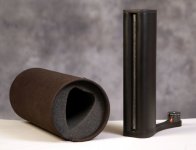
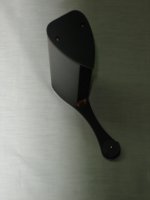

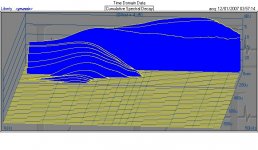
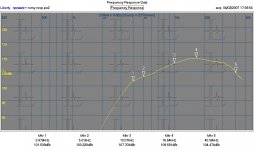
Long time no see! Happy New 2011 to you and everyone!
I stumbled upon your thread here that relates diffraction.
If I may, I'll share my 2cents on this as I've played with designing a ribbon tweeter in a way to prevent the diffraction and improve the smoothness of the response.
What I'll say now, is valid only if you want to get the very best results in war against diffraction. For limited budget speakers, this may not be feasible.
When you think about diffraction, think in pressure gradients.
You shouldn't mount the diaphragm tangentially to the ball. In the vicinity of the diaphragm, pressure and velocity vectors are not aligned. Air molecules velocity will propagate in forward-back direction, but air pressure will try to move away in all directions as fast as possible, i.e. as soon as the path opens.
I wasn't able to analyze this directly, but there is a great deal of analogy that I see to propagation of magnetic fields, so i made predictions that turned out to be very good and the result was excellent in the first trial.
Anyway, housing must initially follow the particle velocity direction, allow for gradual alignment of velocity and pressure propagation along the way and slowly turn back. It looks pretty much like a short horn folding all the way back, with absorption at the meeting point in the back, which is optional.
Pictures and measurements attached. I don't consider the drawing confidential any more. I don't have the polar plot, but I bet it is at least 180 at 15k, as it sounded like that.
Frequency response measurement is raw data, just like CSD and Impulse response. No smoothing. The triangle "intro" before the rising edge of the impulse is a D/A converter artefact. The positive peak of the impulse response looks lower than the negative, but in fact, the positive peak maximum fell between 15us sampling periods and it's interpolated to a lower value. It is actually very much the same like the negative peak, as this is pretty high-pass speaker, naturally. I haven't saved any more measurements.
Since this is a line source super-tweeter, it looks like extruded heart shape. Your thing could look like an apple with a dome in place of a stem, and now you have an orange, and you know what hey say about apples and oranges! 😀
Cheers!





Hi Alex ! Happy New Years too. Your tweeter looks very interesting and it makes me think how i should shape the sphere but i am not that far right now. I have also seen that you have made a nice dipole ribbon. I may need that for another project. I sill use your ribbon in one of my refference systems and i am still 100% happy. Your stuff is not cheap but when only the best will do .......
Hello,
I believe that we should slice up those apples, oranges, plus some banana and serve it up in an Ikea truncated cone. Sounds good to me.
Wave theory, particle velocity and pressure in a fluid all sound academic to me.
You gurus are not on the same page. The mid is mounted tangent the sphere, the tweeter is not.
The AES papers and text books are filled with pages of graphs showing that the sphere is the ideal baffle for a point source. This ZDL seems like the application of the theory in a real world practical test.
DT
All just for fun!
I believe that we should slice up those apples, oranges, plus some banana and serve it up in an Ikea truncated cone. Sounds good to me.
Wave theory, particle velocity and pressure in a fluid all sound academic to me.
You gurus are not on the same page. The mid is mounted tangent the sphere, the tweeter is not.
The AES papers and text books are filled with pages of graphs showing that the sphere is the ideal baffle for a point source. This ZDL seems like the application of the theory in a real world practical test.
DT
All just for fun!
Last edited:
Yes DT, i use intuition, experience and measurement here mostly. What i can see more and more now is that the way the crossover is set up will be critical. The next problem is how to fix the midrange in the PE sphere becaue that material is nearly imposible to glue and not easy to machine with the tools i have at hand.
Try hot-melt glue- that will give you a chance.
Do you have access to a good Tesla coil? If so, you can increase the PE surface energy (and hence adhesion) by running sparks over it. Another way (high ***-up factor, but effective) is to run a flame over the surface that you want to glue. You want to hit it with enough flame to activate the surface, but not so much that you destroy it.
Do you have access to a good Tesla coil? If so, you can increase the PE surface energy (and hence adhesion) by running sparks over it. Another way (high ***-up factor, but effective) is to run a flame over the surface that you want to glue. You want to hit it with enough flame to activate the surface, but not so much that you destroy it.
Yes DT, i use intuition, experience and measurement here mostly. What i can see more and more now is that the way the crossover is set up will be critical. The next problem is how to fix the midrange in the PE sphere becaue that material is nearly imposible to glue and not easy to machine with the tools i have at hand.
Hello,
I am on the edge of my seat reading about this speaker in a sphere thing, really a recliner with the computer in my lap.
I am glad that you sort of ask about working the PE or PP plastic material. I am a mechanical kind of guy. At my night job i teach pipe trade stuff including welding plastic pipe. PE, PP, PVDF and all the other poly things are chemically resistant; glue does not work on them. What does work is heat. If you have a hot air soldering station you may have a tool that will work. Plastic PE, PP or whatever your choice, welding rod is made for hot air welding of those materials. Cut a V groove between the work pieces you want to join and practice with the hot air in one hand and the plastic rod in the other. Somewhere between not hot enough and burning is just right. If we shared the same latitude i could show you.
A plunging wood router and jigs may be worth a try. The wood cutting router bits should work well. In this case heat is not your friend.
DT
All just for fun!
Joachim, I'm very happy that you're satisfied with the tweeters, thank you.
What would be the distance between the centers of the mid and the tweeter that you would want to use?
The closer-the better approach or...?
Thanks, soongsc!
What would be the distance between the centers of the mid and the tweeter that you would want to use?
The closer-the better approach or...?
Thanks, soongsc!
- Status
- Not open for further replies.
